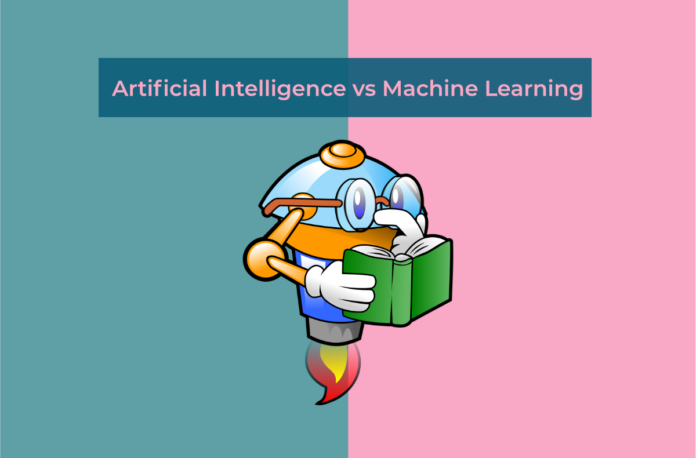Artificial intelligence (AI) and machine learning (ML) are two frequently hyped terms today.
And people are often seen using them relatively to define an intelligent system or software.
While both AI and ML are dependent upon mathematics or statistics, they aren’t the same thing.
This article will tell you the differences between AI and ML with a few practical examples to clear your doubts.
What is Artificial Intelligence (AI)?
Artificial intelligence, which is abbreviated as AI, allows a machine or a computer to imitate or mimic human intelligent behavior and do human-like tasks.
AI essentially involves activities that demand human intelligence including learning from experience, reasoning, thinking, and most importantly, making its own decisions.
“AI is the science and engineering of making intelligent machines.” — John McCarthy
Artificial intelligence is, though, capable of performing activities remarkably well, so far this technology hasn’t been able to interact with people at a truly emotional level.
To know more about artificial intelligence (AI), let’s check a few examples of AI in action.
Industrial Robotics
Industrial robots are the best examples of artificial intelligence. These types of robots cannot only monitor their performance and accuracy but are also capable of sensing and detecting when it comes to the requirement of maintenance to avoid expensive downtime.
In addition, they are also capable of acting during unknown and new environments.
Personal Assistants Tool
Personal assistant tools are the second-best example of AI. They are Human-AI interaction gadgets.
Some of the most frequently used personal assistants tools available today include Siri by Apple, Google Home by Google, Alexa by Amazon, and Cortana by Microsoft.
These voice assistants help users to book hotels, get information, add events to calendars, schedule meetings, answer questions, send emails or messages, and so on.
Apart from the above examples of AI, you can also check out the following AI tools:
- Natural Language Processing (NLP) tools
- Proactive healthcare management
- Automated financial investing
- Conversational marketing bot
- Virtual travel booking agent
- Social media monitoring
- Manufacturing robots
- Inter-team chat tool
- Disease mapping
- Self-driving cars
- Smart assistants
What is Machine Learning (ML)?
Machine learning (ML) is the subset of artificial intelligence (AI). Learning in ML connotes the ability of a machine to learn, based on the data and the ability of an ML algorithm to train a model, assess its accuracy or performance, and then make predictions.
It can automatically learn from the data without explicitly being assisted or programmed by domain expertise. For instance, a system can be trained with supervised machine learning algorithms including Decision Trees and Random Forest.
“Machine learning is the field of study that gives computers the ability to learn without being explicitly programmed.” — Arthur Samuel
The purpose of machine learning (ML) is to allow machines or computer systems to learn automatically by using the existing data and based on that making correct predictions.
To learn more about Machine Learning (ML), let’s check a few examples of ML in action.
Product Recommendations
Machine learning tools are used by most e-commerce websites today. These great ML tools help with recommendations of different products based on historical data.
For instance, if you make a search for machine learning books on Amazon and choose to purchase one from there if you return on the same platform after some time, the home page of Amazon will give you a list of books related to machine learning.
At the same time, it also makes further recommendations based on your feedback and activities such as what you liked earlier, added to your cart, and other related behaviors.
Email Spam and Malware Filtering
Whether you use Gmail, Yahoo!, or any other email sending or receiving platform. You must have faced the problems of unwanted or undesired commercial bulk emails (spam).
Receiving unwanted commercial bulk emails (spam) is the problem for every internet user today.
Hence, most email service providers now use machine learning tools, which are capable of automatically learning and identifying spam emails and phishing messages.
Let’s take for example the Gmail and Yahoo! mail spam filters, which not only check and identify the spam emails using pre-existing rules but also do more than that.
Being continued in their spam filtering operations, they create their own new rules based on their findings and learnings during the finding, detecting, and filtering operations.
A few machine learning algorithms including Multi-Layer Perceptron, Decision tree, and Naïve Bayes classifier are used for malware detection and email spam filtering.
So, how different is AI from ML?
Well, where AI helps in solving tasks that need human intelligence, ML, being a subset of AI, helps in solving certain tasks, based on its learning from the extracted data and then making predictions. In all, this points out that all ML is AI, but not all AI is ML.
Key differences between Artificial Intelligence (AI) and Machine learning (ML):
| Artificial Intelligence | Machine Learning |
| Artificial intelligence is a technology which enables a machine to simulate human behavior. | Machine learning is a subset of AI which allows a machine to automatically learn from past data without programming explicitly. |
| The goal of AI is to make a smart computer system like humans to solve complex problems. | The goal of ML is to allow machines to learn from data so that they can give accurate output. |
| In AI, we make intelligent systems to perform any task like a human. | In ML, we teach machines with data to perform a particular task and give an accurate result. |
| Machine learning and deep learning are the two main subsets of AI. | Deep learning is a main subset of machine learning. |
| AI has a very wide range of scope. | Machine learning has a limited scope. |
| AI is working to create an intelligent system which can perform various complex tasks. | Machine learning is working to create machines that can perform only those specific tasks for which they are trained. |
| AI systems are concerned about maximizing the chances of success. | Machine learning is mainly concerned about accuracy and patterns. |
| On the basis of capabilities, AI can be divided into three types, which are Weak AI, General AI, and Strong AI. | Machine learning can also be divided into mainly three types that are Supervised learning, Unsupervised learning, and Reinforcement learning. |
| It includes learning, reasoning, and self -correction. | It includes learning and self-correction when introduced with new data. |
| AI completely deals with Structured, semi-structured, and unstructured data. | Machine learning deals with Structured and semi-structured data. |
After reading the article about the key difference between artificial intelligence and machine learning, we hope that you would like to know more about the artificial intelligence and machine learning and AI/ML consultant who can best guide you in the AI and ML implementation.
If you have any questions about which technologies (AI and ML) you should choose to implement for your business growth, we would be happy to answer all of them in the comment section below.



